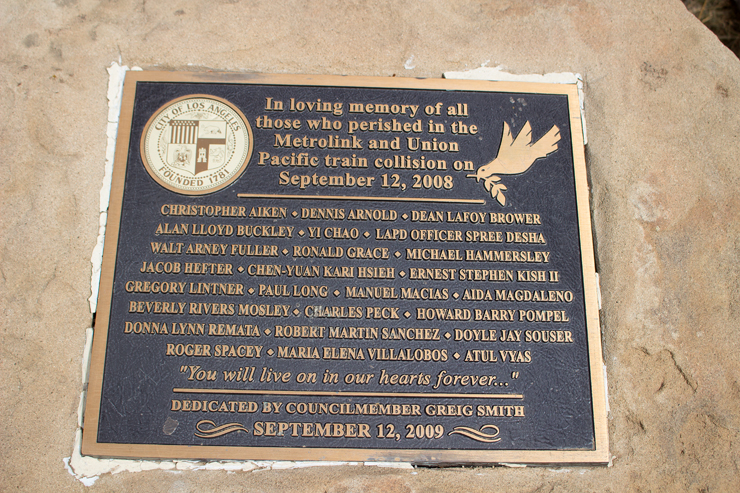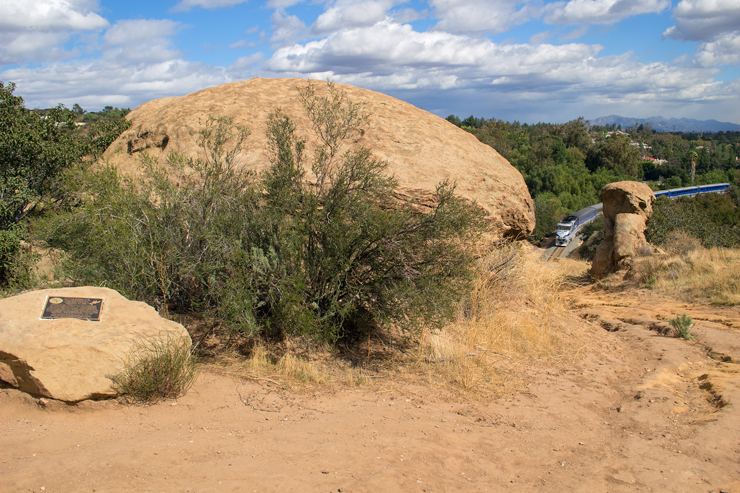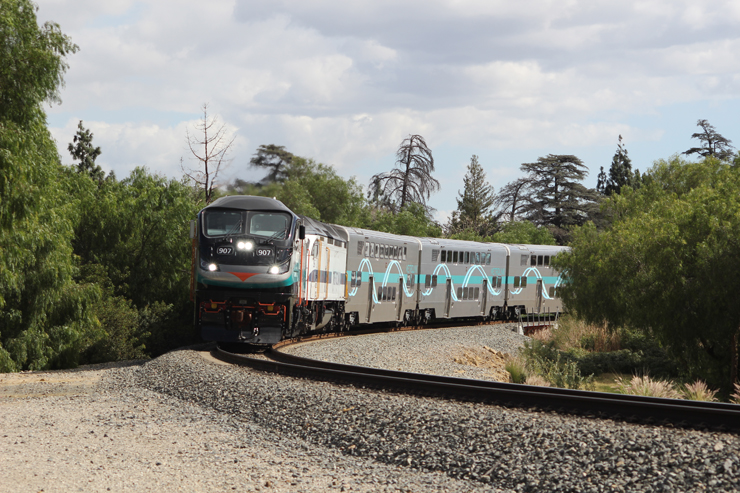CHATSWORTH, Calif. — On Sept. 12, 2008, an engineer on a commuter train received a text message. The railroad industry is still struggling to deal with the aftermath of the events that followed.
That day, at approximately 4:20 p.m., Metrolink train No. 111 departed the Chatsworth, Calif., station. Not long after the westbound train departed, its engineer, 47-year-old Robert M. Sanchez, received a text, Over the next two minutes, as the commuter train accelerated along the tangent track north of the Chatsworth depot, Sanchez divided his attention between sounding the horn for a number of road crossings and answering the message he had just received.
In the process of typing out that message, Sanchez apparently missed a red signal. Train No. 111 passed the signal, went through a switch that had been set against it and entered a curve at approximately 43 miles per hour. Twenty-one seconds later, the train ran head-on into a Union Pacific freight.
The wreck of Metrolink No. 111 and UP’s Leesdale Local resulted in the death of 25 people, including Sanchez. The tragedy became the catalyst for the federal government to enact legislation requiring railroads to install positive train control, a technology designed to prevent speed-related derailments and head-on collisions. Just a month after the Chatsworth wreck, President George W. Bush signed the Rail Safety Improvement Act of 2008 into law.
But exactly a decade after the Chatsworth wreck, railroads are still struggling to implement PTC, a technology that was still very much in its infancy back in 2008. The railroad industry spent millions of dollars developing and installing PTC but many operators fell short in meeting a federally mandated deadline. In 2015, Congress extended the deadline to Dec. 31, 2018, but even with extra time it appears some companies won’t be ready.
National Transportation Safety Board Chairman Robert L. Sumwalt III says that’s simply unacceptable.
“The NTSB is gravely concerned the majority of our nation’s railroads — passenger railroads in particular — required to install PTC will not meet the Dec. 31, 2018, deadline,” Sumwalt tells Trains News Wire. “Each day railroads are operated without PTC, is another day we are at risk for another tragic, preventable, accident.”
Former National Transportation Safety Board Chair and President of the National Safety Council Deborah Hersman has been particularly critical of the delays in installing PTC.
Hersman says she first saw the need for PTC when investigating the collision of two Norfolk Southern freight trains in Graniteville, S.C., in 2005. Since then, the number of crashes that could have been prevented with PTC has continued to climb, says Hersman. Most notable among them are the wreck of Amtrak train No. 188 in Philadelphia in 2015, the derailment of Amtrak train No. 501 in Washington in 2017 and a head-on collision involving the Amtrak Silver Star in South Carolina earlier this year.
The NTSB has been calling for the implementation of PTC since 1990, but it wasn’t until the Chatsworth incident that politicians heeded the request.
“It has been a decade since the Metrolink tragedy in Chatsworth that killed 25 people and catalyzed Congressional action on PTC,” Hersman tells Trains News Wire. “In the intervening years we’ve seen focused efforts by some and foot dragging by others. The good news is we will be safer when PTC is fully operational on all required routes, but the bad news is that we’ll likely see additional tragedies before the work is completed.”
Metrolink is among the small number of railroads that has fully installed PTC, says spokesperson Scott Johnson. Metrolink installed PTC technology along all of its routes and in all of its locomotives and cab cars by the time Congress extended the first deadline back in 2015.
“Positive train control is a silver lining that emerged from this tragedy. Chatsworth forced the rail industry to install this life saving technology,” Johnson tells Trains News Wire. “We want to make sure that something like the Chatsworth collision never happens again.”
Besides installing PTC, Metrolink also installed in-cab cameras to make sure crews were staying off their mobile devices and it purchased cab cars with crash energy management technology. The cars feature redesigned seats and work tables, and advanced energy absorbing zones at each end of the cars that are supposed to save lives in the event of a collision.
On Wednesday, Metrolink is holding an event at Los Angeles Union Station to mark the 10th anniversary of the Chatsworth wreck. The daughters of one of the victim’s will ring the bell of the locomotive that was in the wreck to honor those who died. Metrolink will also debut a rail safety exhibit that will showcase the measures to increase safety in the last decade.
“Metrolink’s culture changed after Chatsworth,” Johnson says. “Our No. 1 goal now is to make sure that Metrolink is the safest passenger rail operation in America.”
— The Chatsworth accident and its aftermath are covered in detail in “Fatal Distraction,” an article in Trains’ special issue, Train Wrecks Vol. 2.

















Ahem, that Silver Star collision was CAUSED by PTC–the signals were shut down for the installation of PTC. If PTC weren’t happening there wouldn’t have been a head-on. I’m expecting the errors in PTC to start showing up as soon as it’s in place. Wireless signals can be spotty, so can GPS, and I live right beside a major error in a lot of highway GPS systems and can remember when the local police several times a month were having to back tractor-trailers stuck at a dead-end intersection back out of it instead of getting on I-93 because of this error. A certain state agency nearly submitted a major report with this same error prominent on its front page–fortunately I alerted them in time. There ARE errors in GPS and I don’t think PTC will be cost-effective; I’ve been observing the nightly testing of the PTC system locally. Lastly, all Amtrak trains on “dark” railroads are doomed unless Amtrak gets a new president who doesn’t think he’s running an airline on the ground.
Howard, did you post comments like that on September 11th as well? Fortunately this young woman will probably never have to read the hurt in them.
As for the technology, no one with any knowledge on technical systems like this would ever say that it will prevent all tragedies, but the technology for PTC will work and can be sustained. What is frustrating are the companies that drug their feet due to politics (NJ Transit) and are using it as an excuse to drop service (Amtrak)…oh wait, thats politics too!
Dennis my comment was not meant to minimize the daughters action and feelings but to show how that the response to the gravity of the accident by politicos and industry was feel good but so far ineffective. As for Sept 11th, as the oldest active member of the Rochester Fire Department and a retired RR engineer I have seen way more death and destruction than you could imagine. I spent a lot of time at the firehouse across the street from the apartment I stayed at in Tribeca on frequent business trips to the city. I personally knew many of the first responders. On my first return the site I viewed the unabridged video of these guys I knew so well and emotionally collapsed , a first, so I do understand the deep loss. Although not stated clearly in the short post my criticism was of the regulators, the politicians and the industry’s knee jerk ineffective response.
I feel so good the daughter will ring a bell, that’s the feel good age we live in. Too bad the technology is so complex and expensive and is still not fail safe. I blame those companies the bent over and took it in the rear when there no off the shelf proven answer.
Isn’t the plaque a bit hidden away for someone to see? Nobody’s going to hike up the moutain to find it anytime soon, I’d bet. I know there’s a fence between the road and the tracks at the crash site but come on alre
To the unknown and sage commenter below, I’d like to add a transformational event —
It was the first time my phone rang at oh-early-thirty with a preliminary accident report that included this sentence, “It’s looking bad, and we may have a fatality.”